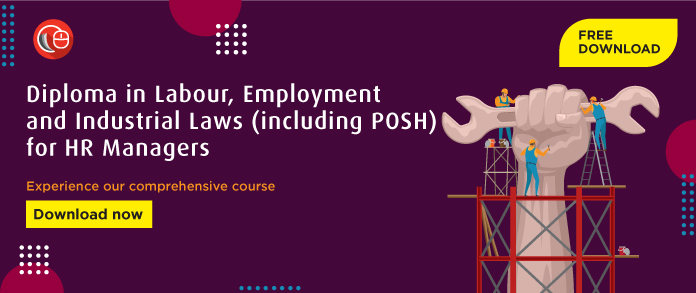This article is written by Rahul Sharma, pursuing a Certificate Course in Labour, Employment and Industrial Laws for HR Managers from LawSikho. This article has been edited by Zigishu Singh (Associate, Lawsikho) and Smriti Katiyar (Associate, Lawsikho).
Table of Contents
Introduction
When it comes to building a superior employee experience, effective Human Resource (HR) operations are the key to delivering this mandate, and payroll services are something that has become a hygiene factor for the top organizations. In this article, we would first briefly touch upon a state-of-the-art payroll process to understand what a good process looks like. Next, we would break down a typical salary structure to evaluate the impact of various statutes on different pay components.
Payroll process
The starting point of the payroll process is anchored in the HR organisation, usually, a payroll specialist, who maintains the master data of employees (new, active, and exit). As a part of the onboarding process, the bank account details of the new employee are collected, and a salary break-up is shared along with the employment contract. Every payroll cycle has a cut-off date for accepting the additions and deductions for a given employee. Additions could be for shift allowances, incentives, joining bonus, travel settlement pay, reimbursements, etc., and deductions can be made for fines, insurance, salary advance, travel settlement recovery, leave without pay, contributions, etc. The payroll specialist validates these inputs and prepares the salary master file which is shared with the payroll vendor. This salary master sheet has four basic elements to it, namely employee master (employee name, date of joining, email, Provident Fund (PF) option, Permanent Account Number (PAN), Bank account details), a financial master (contains the cost of company structure and details of the components), resigned and salary hold (contains the list of people in notice period and their last working date), one-time payment/deduction (contains the earnings and deductions).
The payroll vendor starts the next set of activities when they receive inputs from the payroll specialist. A professional vendor would have a system for actual payroll processing when the received data is fed into it. The system calculates the payable amount (in-hand salary) based on the tax declarations/actual submitted to the vendor. The output file is the result of this activity, and there are two files that are shared with payroll specialists to review and approve – salary register, active and left, and bank transfer files. The finance team uses the bank transfer file to make the payments to the employees.
Once the salaries are disbursed, the payroll vendor shares the statutory reports. All statutory deductions like Employees Provident Fund (EPF), Tax Deduction at Source (TDS), Professional Tax (PT) are deducted at the time of processing payroll and the reports will be shared with the finance team. The finance team then remits the amount to the respective government agencies. The frequency can vary depending on the type of the dues. In most cases, payment of dues is made via challans. After all, dues are paid, a return/report is filed. e.g. for filing PF return, ECR(Electronic Challan cum Return) is generated and filed.
Individual records of various statutory deductions are maintained which will later be used to issue form-16 for employees for filing tax returns. In the below table, you can find the current rates for these contributions and tax deductions.
Present rates of contributions – PF
| By | Contribution Accounts | ||
| EPF | EPS | EDLI | |
| Employee | 12/ 10% | 0 | 0 |
| Employer | Difference of Employee Share (EE) share and Pension Contribution | 8.33% | 0.50% |
Regulation of salary, wages, and bonus
The labour legislation governing the payment of salaries and remuneration are:
- The Minimum Wages Act, 1948.
- The Payment of Wages Act, 1936.
- The Payment of Bonus Act, 1965.
Definition of wages
Earlier the HR community had confusions about the definition of the wages between different acts as above. The definition of wage as per Section 2(y) of the new Wage Code states that:
The new definition of ‘wages’ –
a. Includes basic pay, dearness allowance and retaining allowance, and
b. Excludes certain pay components such as house rent allowance, bonus excluded from the terms of employment, any retrenchment compensation or other retirement benefit, or ex-gratia payment made by an employer.
Critical new elements in the definition
a. The pay components that are excluded from the definition of wages will be ‘deemed’ to form part of wages where these pay components exceed 50% of all the remuneration paid to an employee, and
b. For remuneration paid in kind, up to 15% of such remuneration in kind will be deemed to form part of the wages.
The new deadline to clear full and final settlements
Deadline to pay full and final settlements: According to Section 17(2) of the new Wage Code, the full and final settlement of wages to employees who are removed, dismissed, retrenched, or resign from service must be paid within two working days of their ceasing employment with employer i.e., last working day.
Time
As per the Payment of Wages Act, the time for payment of wages is before the expiry of the 7th day after the last day of the wage period, where there are less than 1000 workers employed and in other cases on the 10th day after the last day of the wage period. For people whose employment is terminated, within two days after termination.
Fines
The total amount of fine which may be imposed in any one wage period on any employed person shall not exceed an amount equal to 3% of the wages payable to him in respect of that wage period.
Maintenance of registers and records
Each applicable establishment must maintain the register of wages, deductions, etc. for all employees. The key point to note on applicability: Payment of Wages Act applies to industrial or other establishments; it does not include offices or other places where services are rendered. Similarly, the industrial disputes act applies to ‘workmen’ in an ‘industry’, and those who work in a shop or office may not qualify as ‘workmen’, and such setups may not qualify as ‘industry’. However, the Shops and Establishments Act in different states have ensured to mirror certain provisions of the above acts to ensure uniform compliance. For example, Telangana Shops and Establishment Act, has listed the provisions related to wages and terminal benefits in chapter VIII.
Salary components and applicable Acts
A typical salary structure has different components and:
| Salary Component | Brief | Act |
| Basic Salary | Basic salary, also called base salary, is the amount of money a salaried employee regularly earns before any additions or deductions are applied to their earnings. | Section 17 of The Minimum Wages Act 1948 |
| House Rent Allowance | House rent allowance is part of the salary provided by the employer for the expenses incurred towards rented accommodation. | Section 10(13A) of the Income Tax Act (IT Act) |
| Sodexo Meal Voucher | A prepaid instrument was issued to purchase food and non-alcoholic beverages. | Section 17 (2)(viii) Rule 3 (7) (iii) of IT Act |
| Children Education Allowance | Allowance towards children’s education. | Section 10(14) of the IT Act |
| Hostel Expenditure Allowance | This allowance is granted to an employee to meet the hostel expenditure on his child. | Section 10(14) of IT Act |
| Telephone & Mobile Allowance | Landline including broadband and mobile phone | Rule 3(7)(ix) of the IT Act |
| Professional Pursuit Allowance | Any amount spent & reimbursement claimed by employees for academic research or other professional pursuits including training, short-term/online course, etc. | Section 10(14) of the IT Act |
| Provident Fund (Company Contribution) | A provident fund is a government-managed, mandatory retirement savings scheme | Section 17(2)(vii) of the IT Act |
| Car Running and maintenance expense | Running and maintenance charges” of motor cars and other vehicles. Includes expenses incurred on petrol/diesel. | 17(2)(viii) Rule 3(2) of IT Act |
| Driver Allowance | Driver salary perquisite | 17(2)(viii) Rule 3(2) of IT Act |
| Special Allowance | Special allowance is a fixed amount that is given over and above the basic salary | |
| Incentive | Performance-based incentive refers to compensation paid out to employees that have performed above and beyond their job requirements | |
| Gratuity | Gratuity is the amount that an employee receives as appreciation for the cumulative service offered to him/her upon leaving the job | Paid as per Gratuity Act 1972 |
| Professional Tax | Profession tax is the tax levied and collected by the state governments in India. It is a direct tax. | Section 16 (iii) of IT Act |
| Leave travel Allowance | LTA is the sum paid by the organization to compensate for domestic travel expenses of employees | Section 10(5) of IT Act |
| NPS | National Pension Scheme (NPS) India is a voluntary and long-term investment plan for retirement | Section 80C and Section 80CCD of the IT Act |
Conclusion
In conclusion, your payroll must be well described with clear segregation of duties to be able to deliver an experience that is uniform, compliant and predictive. There are key legislations that are enacted to regulate salaries and remuneration but also the new wage code bill aims to consolidate and simplify this area by giving a concise definition of wages. However, there are still some open questions on how to work with this new definition of wage.
Students of Lawsikho courses regularly produce writing assignments and work on practical exercises as a part of their coursework and develop themselves in real-life practical skills.
LawSikho has created a telegram group for exchanging legal knowledge, referrals, and various opportunities. You can click on this link and join:https://t.me/joinchat/J_0YrBa4IBSHdpuTfQO_sA
Follow us on Instagram and subscribe to our YouTube channel for more amazing legal content.
 Serato DJ Crack 2025Serato DJ PRO Crack
Serato DJ Crack 2025Serato DJ PRO Crack











 Allow notifications
Allow notifications



